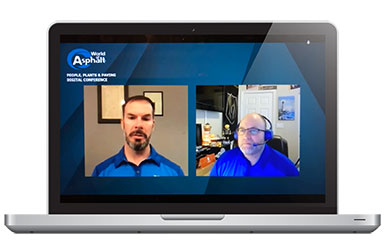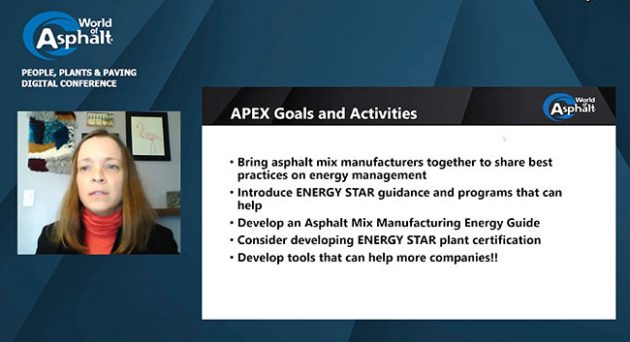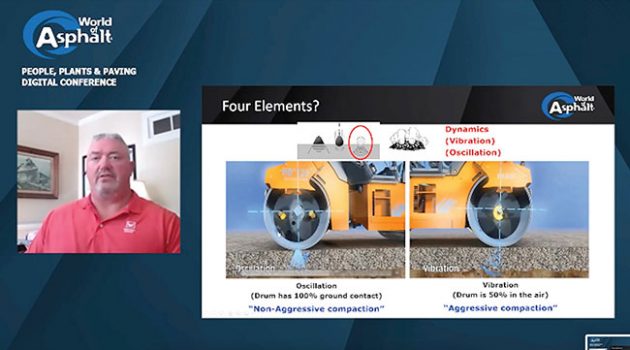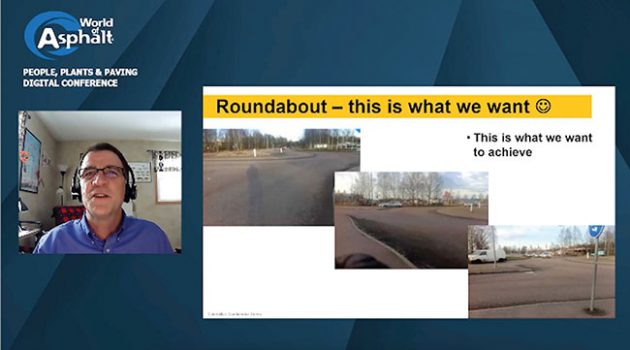
Features
Roads & Paving
World of Asphalt: People, plants and paving
Digital conference showcases latest asphalt techniques
April 8, 2021 By Rock to Road staff report
 Trimble’s Brian Girouard and Kevin Garcia discussed using the latest machine control technology for asphalt paving screeds and mill drums to build longer-lasting roads.
Trimble’s Brian Girouard and Kevin Garcia discussed using the latest machine control technology for asphalt paving screeds and mill drums to build longer-lasting roads.
The World of Asphalt People, Plants and Paving Digital Conference took place from March 9 to 11 with hundreds of industry professionals taking in a wide variety of sessions. Here’s a recap of a few of those sessions.
Best practices for milling and profiling
Tom Chastain, applications specialist for Wirtgen America, presented on best practices for milling and profiling. During the session, Chastain covered understanding the profiling machine operation, maintenance and new innovations; understanding grade and slope control, new ski arrangements, and controls to facilitate smoother cutting and more efficient profiling operations; and determining the effect of cutter tooth patterns in relation to forward speed.
He also focused on maintenance tips to ensure an operator’s milling machine is in top working order for the tough applications they’re designed for.
“They are designed to beat themselves to death,” Chastain says, adding that keeping a milling machine performing at its optimum level is vital for keeping a job site running efficiently, especially in the case of a mill-and-fill type of project. “If the milling machine goes down, everything goes down in the process. It’s a domino effect.”
He says that maintaining the cutter drum is vital for ensuring successful projects.
“If the cutter drum is not in optimum working order, we’re not going to produce the quality or the quantity,” Chastain says.
Some of Chastain’s recommendations for maintaining a cutter drum include:
- Check the milling teeth and holders before the milling machine gets on a jobsite;
- Check the kicker paddles;
- Make sure the drum cooler level is at manufacturer’s specifications;
- Make sure to have spare cutting teeth and holders on site;
- Check the spray nozzles to make sure the water system spray nozzles are spraying the way they’re supposed to; and
- Check the control systems to make sure you’re using the systems that best fit the application.
“If we maintain our machine, we have a better chance to achieve quality,” he says.
Machine Control Technology in Paving and Milling
Trimble’s Brian Girouard and Kevin Garcia discussed using the latest machine control technology for asphalt paving screeds and mill drums to build longer-lasting roads. The session focused on understanding the differences between 2D and 3D machine control systems and the advantages of both; the limitations to machine control and where it shouldn’t be used; and learning how proper work practices merged with machine control can yield exceptional results.
“The goal with 3D milling is to get the surface smooth and right the first time… so our initial lift is uniform and correct,” Girouard said.
Other advantages of 2D and 3D systems that Girouard discussed were decreased asphalt usage and better pavement structures.
Garcia discussed the advantages of pavement thermal mapping, including being able to measure, display and record the asphalt mat temperature directly behind the screen with a high-resolution thermal camera.
“Pavers can share thermal data with each other to see if one machine is paving better than another, or if one is getting better material,” he said.
He also discussed the importance of intelligent compaction and how there is now a lower barrier of entry for these technologies due to decreasing costs.
“There is real value in this,” he said,
Energy management for asphalt plants
The National Asphalt Pavement Association (NAPA) recently announced a partnership with ENERGY STAR’s Industrial Sectors program to help asphalt plants manage and improve their energy performance. Melissa Hulting, section chief of clean air strategies section at the U.S. Environmental Protection Agency, expanded on the various activities and programs available under the ENERGY STAR umbrella.

Melissa Hulting
Her presentation focused on developing and implementing an energy management program for your company; selecting the ENERGY STAR programs that best match your company’s energy management objectives; and finally, how to leverage the ENERGY STAR brand to supplement marketing, community relations, and other external communications.
Hulting gave some easy tips on how to make energy management a priority in the workplace and why it is important to care.
“Change how you view energy costs,” she said. “They are controllable and part of how you manage your business. Another thing you can do is assign someone to track your energy use and costs. Even a simple Excel spreadsheet gives you a baseline to work from.”
She also suggested companies set a goal and engage employees.
“Talk to your utility about available incentives and programs,” she said.
During the sessions, Eugene Weldon, director of environmental at Eurovia USA, also shared from an asphalt producer’s perspective on how his company has already benefitted from some of Hulting’s tips and suggestions.
Compaction 101: Doing the right things, the right way
Tim Kowalski, applications support manager at Wirtgen America gave a presentation covering the basics of compaction.

Tim Kowalski
“Roller compaction is the last opportunity during the paving process to produce a long-lasting and high-quality pavement,” he said. “Why is compaction important? We don’t want things to fall apart and that starts from the bottom up.”
Kowalski covered compaction basics to help prepare contractors for challenges faced during construction operations. He focused on understanding the four elements of compaction, which are: static weight; impacts; dynamics – vibration and oscillation; and finally, kneading. He also focused on how to balance production, laydown, and compaction operations to match paving speed with rolling speed; and how to understand the factors that can affect compaction and how to mitigate negative impacts.
Practices for paving roundabouts and understanding density rolling patterns
Caterpillar Paving product application specialist Todd Mansell presented multiple sessions during the digital conference; including practices for paving roundabouts, understanding density rolling patterns.

Todd Mansell
Mansell focused on planning the paving operation and traffic control, setting up your paver, tips for paving roundabouts, and finished with tips for compacting roundabouts.
“One successful approach to paving roundabouts is to mill the whole existing surface first,” he said. “Repair specific areas if needed, then proceed with paving and milling, finishing by sealing all the joints,” Mansell said, adding that this approach works because it ends up being carefully planned and the details are controlled in the field.
The next World of Asphalt live event is scheduled to take place from March 29 to 31, 2022 in Nashville, Tenn.
Print this page